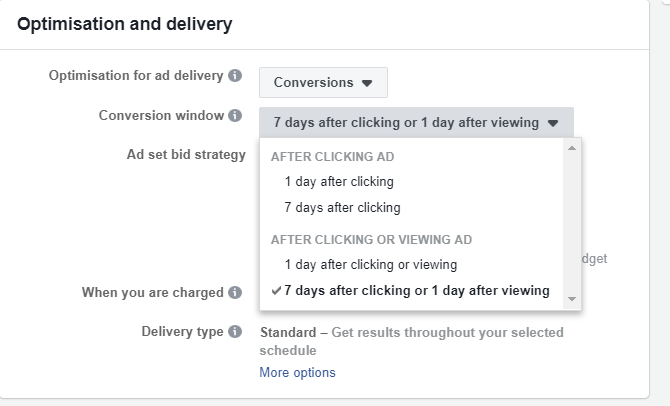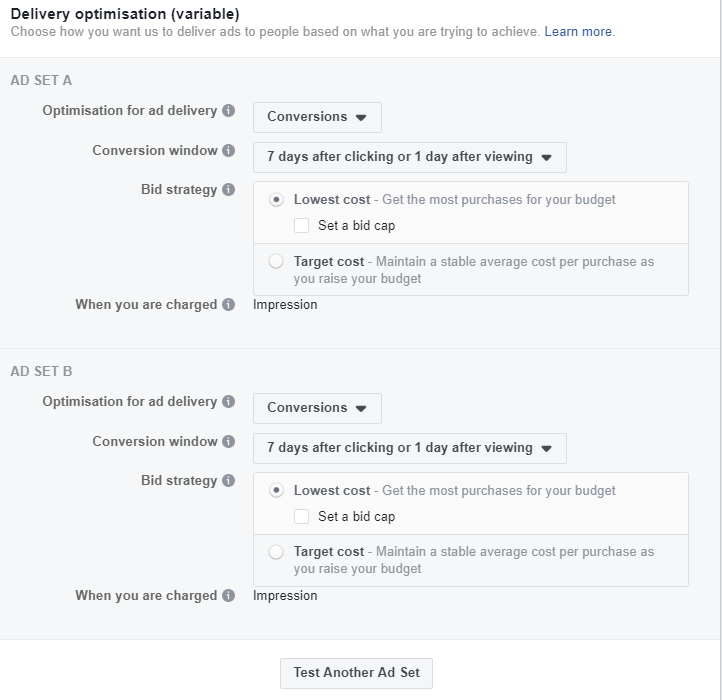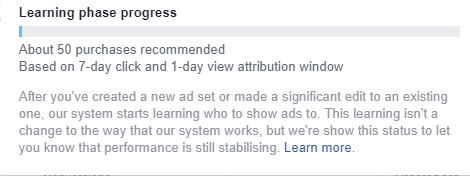When running the conversion objective, Facebook will ask you which conversion window you want to use.

You have four options:
After clicking the ad
- 1 day after clicking
- 7 days after clicking
After clicking or viewing the ad
- 1 day after clicking or viewing
- 7 days after clicking or 1 day after viewing
In this article, I’ll explain how to choose the right conversion window for your campaigns.
What is a conversion window?
A conversion window is the time it takes for a prospect to make the conversion you’re optimizing for.
For example, someone buying a brand new 4K TV is unlikely to convert within one day of seeing your ad. The purchase cycle for large-ticket items can take anywhere from a few days (electronics) to months (cars and homes).
Low-ticket items like clothing or food have shorter purchase cycles and can take anywhere from a few minutes to days to complete a cycle.
If you’re optimizing for add-to-baskets, then they’ll often happen within 24 hours.
You should ask yourself what type of products you have and how long the consideration process is for prospects.
Free mobile app installs, lead magnets, or vouchers tend to work best with a one-day window as the barrier to action is low according to Dusan from VSS Monitoring.
If most purchases from your website are made within 24 hours, then choosing the 1 day after clicking or 1 day after clicking or viewing conversion window will inform Facebook to find you prospects that are likely to convert within one day.
If most purchases take longer than one day, then choosing the 7 days after clicking or 7 days after clicking or 1 day after viewing conversion window makes more sense.
Using a seven-day window is preferable if you want your ads to be awarded the most conversions, but if most of your conversions happen within a one-day window, it will impact the delivery of your ads and they will not be shown to the right people.
If you’re unsure of the average life-cycle of your conversions, you can run an A/B split test on Facebook and test the variable delivery optimization.

This will give you a much better idea of which conversion window to use for your campaigns.
In most cases I’ll use a seven-day window as it gives campaigns a wider time frame to optimize for the correct event. I’ll opt for a one-day window if my client’s business is receiving the bulk of its traffic through organic searches or receiving hundreds of sales per day, but even then I’ll run a test to see which works best.
50 is the magic number
To make best use of conversion windows, Facebook requires each ad-set to receive 50 or more conversions per week. If you’re optimizing for purchases but cannot hit 50 conversions per ad-set (not per campaign), then it’s recommended that you use the next most valuable conversion, which is add-to-carts.
One day or seven day?
There is no ‘one size fits all’ answer to conversion windows. The right amount of time to use conversion windows depends on the products you sell and your audience.
Run your own tests and see which conversion window brings you the lowest CPA.